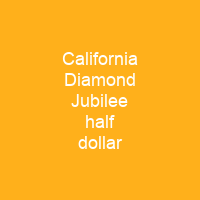The California Diamond Jubilee Half Dollar: A Glittering Gem in American Numismatics
Imagine a piece of history, shimmering like a diamond in the sun—this is what the California Diamond Jubilee half dollar represents. Struck in 1925 to celebrate the 75th anniversary of California statehood, this commemorative coin has a story as rich and complex as its design.
The Birth of an Idea
Back in 1925, the land that is now California was just a glimmering dream for many. The idea to create a commemorative half dollar wasn’t born overnight but rather after much deliberation and debate. A bill was introduced in the Senate on January 9, 1925, with an amendment by California Congressman John E. Raker adding a coin for the state’s milestone anniversary. This addition faced initial opposition from Representative Albert Vestal, but it eventually passed.
The Design Process
Once the bill was signed into law, the design process began. The choice of sculptor Jo Mora was met with some hostility from the Commission of Fine Arts, but his vision for a Gold Rush-era prospector and the Bear Flag’s grizzly bear would eventually shine through. Despite delays and constraints, the Mint created working dies based on a plaster model in July 1925, striking 150,000 coins by August.
A Bold Design
The California Diamond Jubilee half dollar is more than just a piece of metal; it’s an artistic masterpiece. The design features a prospector and the Bear Flag’s grizzly bear, giving it a textured look that has captivated collectors for decades. Experts have praised this coin as one of America’s greatest works of numismatic coinage, citing its bold design, effective lettering, and well-executed motifs.
From Mint to Market
The coins were distributed to various organizations and individuals through sales at a celebration in San Francisco. However, distribution efforts weren’t as coordinated as they should have been, leading to many coins being returned for melting. Despite this setback, the coin’s value has fluctuated over the years, with some specimens fetching significant amounts.
Valuable Insights
According to various sources, including United States Commemorative Coinage, the California Diamond Jubilee half dollar is now catalogued at between $200 and $1,300. Some exceptional specimens have even sold for more than this range. The coin’s value has been influenced by factors such as condition, rarity, and historical significance.
Conclusion
The California Diamond Jubilee half dollar is a testament to the rich history of American numismatics. It stands as a shining example of how a piece of metal can carry so much meaning and value. As we look back at this coin’s journey, it reminds us that every story has its beginning, middle, and end—just like the California Diamond Jubilee half dollar.

You want to know more about California Diamond Jubilee half dollar?
This page is based on the article California Diamond Jubilee half dollar published in Wikipedia (retrieved on November 29, 2024) and was automatically summarized using artificial intelligence.







